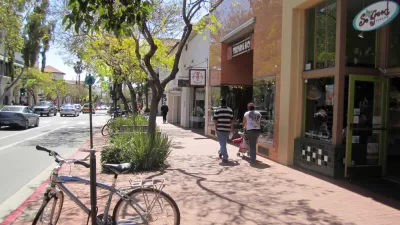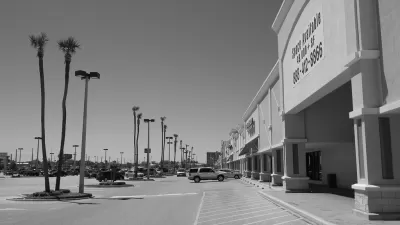Walkability

How Did Vancouver Decrease its Traffic While Growing its Population?
With its elegant skyline, walkable streets and stunning parks, Vancouver exemplifies great city-making. Add to the list of achievements the city's ability to reduce traffic by 20 to 30 percent since 2006 while growing its population by 4.5 percent.
Lack of Walkability in Suburban Areas Threatens Kids' Safety, Health
A recent fight over school-bus service in Loudoun County, Virginia highlights the ways in which suburban growth patterns hamper walkability and harm the health of children.
Familiarity Fostered on Foot Breeds Social Movements
A new study suggests that density, mixed-use neighborhoods, short city blocks, and, crucially, walkability foment political and social activism, reports Richard Florida.
Red or Blue, States Demand Walkable Urbanism
A new study by the Sonoran Institute finds unmet demand for walkable neighborhoods in the western American states of Idaho, Montana and Colorado. In these states, houses in walkable areas sell for markedly more than in sprawling areas.
Efforts to Boost Walkability Meet Hostility in Twin Cities’ Suburbs
A fragmented network of sidewalks is commonplace in the suburbs of Hennepin County, Minnesota. Mary Jane Smetanka reports on controversial efforts to fill in the gaps and retrofit these suburban neighborhoods as walkable places.

Taking the Guesswork out of Designing for Walkability
The lack of adequate pedestrian behavior models means that designing for walkability has largely remained a matter of intuition. However, agent-based simulation can provide insight into the keys for creating pedestrian-friendly places.
The Importance of Retail Design to the Future of Our Cities and Towns
Much of the future built environment will be determined by how commercial sites are developed, says Robert Steuteville. And it's up to cities and towns to demand better retail designs.
Walking: America's Next Medical Breakthrough
A group of America's leading corporations, health care providers, and government officials are preparing to launch a national walking movement this fall. "If walking was a pill or surgical procedure, it would be on 60 Minutes,” says Dr. Bob Sallis.
Does Walkability Equal Walking?
Using data from the Women’s Health Initiative, a new study reveals that a walkable environment may not be enough to get people to walk more.

Driven into Poverty: Walkable Urbanism and the Suburbanization of Poverty
David Moser pens a compelling essay that examines the ways in which sprawling auto-dependent land use patterns exacerbate poverty. As more low-income individuals and families are pushed to the suburbs, "this problem is gaining urgency."
Cleveland's Public Space Revolution
With new bike paths, regional trails, and renovated parks, Cleveland is catering to bikes and pedestrians, says Steven Litt. He explains how this "car town" is "undergoing a revolution in attitudes toward public space, city streets and walkability."

10-Year Study Confirms Public Health Benefits of Walkability
A newly published University of Melbourne study ten years in the making reveals that increased access to shops, parks, and other amenities increased walking and overall health.
An Elegant Guide to Walkability
The Spanish city of Pontevedra has developed an innovative, and attractive, map of pedestrian connections based on the color-coded subway maps common to cities around the world; burnishing its reputation as "a leader in walker-friendly urban policy."
A Guide to Creating Great Cities at Eye Level
The result of a collaborative effort between five editors and 43 professionals from around the world, a new open-source book documents the essential concepts and strategies for creating great cities at eye level - along the ground floor ("plinths").
Connections, Community, and the Science of Loneliness
Can urban form help address the loneliness that so often accompanies aging? In a new blog post, Hazel Borys examines some remedies for severed connections.
Using Pictures to Think About Cities
How does each of us perceive the city? Using photos of pedestrians in Seattle crosswalks and the highly walkable Las Ramblas in Barcelona, Chuck Wolfe challenges readers to think for themselves about what they see.
For Walkability, the Journey is as Important as the Destination
This Big City reviews a new book by urban designer Julie Campoli that explores the elements crucial to creating walkable places. "Simply having shops, services and venues within walking distance is not enough."
Is a New Approach Needed for Getting Kids to School?
Charles Marohn derides the conflicted approach to creating "Safe Routes to Schools" in the United States. With new data linking transport to school to educational outcomes, is it time to rethink the federal government's popular program?
3 Simple Ways to Make Streets More Walkable
Although leaders in the Twin Cities seem to agree on the need to improve the appeal of city streets for those on foot, turning those words into actions seems difficult. Bill Lindeke offers three easy solutions that don't involve touching the street.
Yes You Can (Get Groceries Without A Car)
Shopping for bulky items can be one of the challenges of living car free. Here are three of the best ways I've found for dealing with the problem.
Pagination
Urban Design for Planners 1: Software Tools
This six-course series explores essential urban design concepts using open source software and equips planners with the tools they need to participate fully in the urban design process.
Planning for Universal Design
Learn the tools for implementing Universal Design in planning regulations.
Clanton & Associates, Inc.
Jessamine County Fiscal Court
Institute for Housing and Urban Development Studies (IHS)
City of Grandview
Harvard GSD Executive Education
Toledo-Lucas County Plan Commissions
Salt Lake City
NYU Wagner Graduate School of Public Service


































